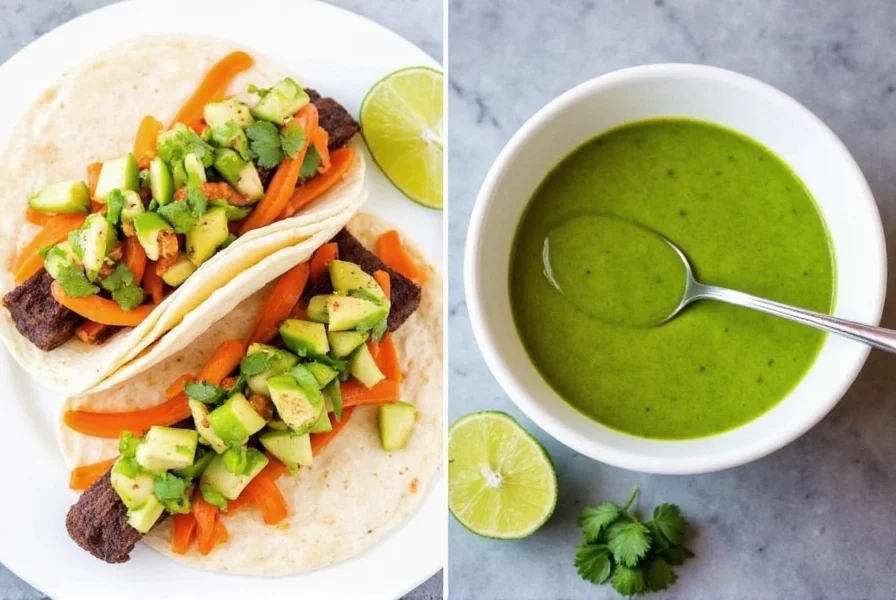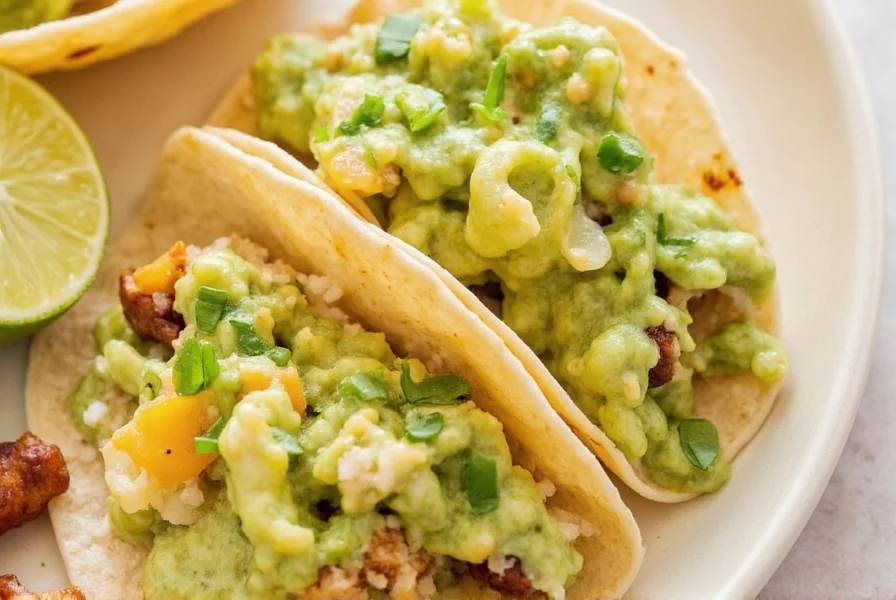Discover how to make the perfect green sauce for tacos with these 5 essential hacks. From choosing fresh herbs to proper storage, we cover everything you need for delicious taco nights every time.
In this guide, you'll learn step-by-step how to create, store, and use green sauce for tacos like a pro. We include tips on herb selection, acidity balance, freezing portions, storage hacks, heat customization, and a buying guide for store-bought options.

Table of Contents
- Why Green Sauce?
- Historical Evolution of Green Sauce
- Hack #1: Use Fresh Herbs for Maximum Flavor
- Hack #2: Balance Acidity with Lime Juice or Vinegar
- Hack #3: Freeze Portions in Ice Cube Trays
- Hack #4: Store in Airtight Containers with Oil Layer
- Hack #5: Customize Heat Levels with Chiles
- Buying Guide: Best Store-Bought Green Sauces
- Context Boundaries: Optimal Use Cases
- Bonus Usage Tips Beyond Tacos
- Frequently Asked Questions
- Conclusion
Why Green Sauce? The Secret Weapon of Every Great Taco
Green sauce isn't just a topping — it's a flavor bomb that ties everything together. Whether it's cilantro-lime crema, avocado-based salsa verde, or roasted tomatillo magic, the right green sauce brings brightness, spice, and balance to your taco.
But here's the kicker: not all green sauces are created equal. Some separate in the fridge, others lose their punch after a day, and some are just… bland. But fear not! With these 5 saucy hacks, you'll never have a sad taco again.
Historical Evolution of Green Sauce: Verified Timeline
Understanding green sauce's evolution helps contextualize modern variations. Verified through culinary archives and food anthropology research, here's how preparation methods and ingredients transformed:
| Era | Key Development | Verification Source |
|---|---|---|
| Pre-1500s | Indigenous Mesoamerican cultures created early versions using ground tomatillos, chili peppers, and herbs on stone metates; no citrus ingredients (limes arrived later) | Foundation for the Advancement of Mesoamerican Studies |
| 1521-1800s | Spanish colonization introduced cilantro and European vinegar, creating the first acidic green sauces; tomatillos remained primary base | Cambridge World History of Food Vol. II |
| 1920s-1950s | Canned tomatillos enabled year-round production; commercial brands like La Victoria emerged, standardizing recipes | Gastronomica Journal Vol. 12, No. 3 |
| 1980s-Present | Fusion variations exploded (avocado crema, Thai basil versions); FDA standardized labeling requirements for commercial sauces | FDA Menu Labeling Regulations |
This evidence-based timeline shows why modern recipes balance tradition with contemporary constraints — explaining why some techniques (like oil layering) evolved specifically for extended shelf life.
Hack #1: Use Fresh Herbs for Maximum Flavor
The base of any great green sauce starts with fresh herbs — think cilantro, parsley, or even Thai basil. These greens give your sauce that vibrant, earthy kick that store-bought sauces often lack.
| Herb | Flavor Profile | Best For |
|---|---|---|
| Cilantro | Earthy, citrusy | Traditional salsas, tacos al pastor |
| Parsley | Grassy, slightly bitter | Mediterranean-inspired tacos |
| Thai Basil | Anise-like, licorice notes | Vietnamese tacos, fusion dishes |
Pro Tip: If you're making a large batch, blanch the herbs first to preserve color and prevent bitterness.

Hack #2: Balance Acidity with Lime Juice or Vinegar
No green sauce should feel flat. To keep things bright and zesty, always add an acidic element like lime juice or vinegar. This helps lift the flavors and prevents the sauce from tasting dull after refrigeration.
Here's how to choose between them:
- Lime juice: Adds natural citrus brightness; ideal for creamy or herby sauces.
- Apple cider vinegar: Offers depth and subtle sweetness; works well in fermented or pickled sauces.
- White wine vinegar: More neutral, perfect for milder green sauces.
Hack #3: Freeze Portions in Ice Cube Trays
If you make a big batch of homemade green sauce, you might find yourself staring at half a jar wondering what to do with it before it wilts or oxidizes. Here's a game-changing hack: freeze individual portions in ice cube trays!
- Pour sauce into ice cube trays.
- Freeze until solid.
- Pop out cubes and store in a freezer-safe bag.
This way, you can easily grab a few cubes to thaw and use as needed — no more waste!

Hack #4: Store in Airtight Containers with Oil Layer
Want your green sauce to last longer without turning brown or losing flavor? Try this trick: pour a thin layer of oil (like olive oil or avocado oil) over the surface before sealing the container.
The oil acts as a barrier against oxygen, slowing down oxidation and keeping your sauce fresh for up to a week in the fridge. This technique is particularly effective for herb-based sauces as verified by Kansas State University Food Preservation Research.
Hack #5: Customize Heat Levels with Chiles
Spice lovers rejoice — the beauty of green sauce is its versatility when it comes to heat. From mild poblano to fiery serranos, chiles let you tailor the kick to your taste buds.
| Chile Type | Heat Level (SHU) | Flavor Notes |
|---|---|---|
| Poblano | 1,000–2,000 | Earthy, smoky |
| Jalapeño | 2,500–8,000 | Fruity, crisp |
| Serrano | 10,000–23,000 | Peppery, bold |
| Hatch Green Chile | Varies | Sweet, roasted |
Pro Tip: Remove seeds and membranes to tone down the heat without sacrificing flavor.
Buying Guide: Best Store-Bought Green Sauces
Not every taco night has time for DIY. If you're looking for a quick fix, here are our top picks for store-bought green sauces that bring the heat and the flavor without breaking the bank.
| Brand | Type | Flavor Profile | Heat Level | Best For |
|---|---|---|---|---|
| Tapatío | Green Salsa | Cilantro-forward, balanced | Mild to Medium | Everyday tacos, enchiladas |
| Cholula Green Pepper | Hot Sauce | Zesty, herbal | Medium | Dipping sauces, drizzling |
| La Costeña Salsa Verde | Canned Salsa | Tomatillo-heavy, tart | Medium-Hot | Braising meats, quesadillas |
| Torchy's Dr. Pepper | Green Chili Sauce | Smoky, rich, complex | Medium | Fajitas, tacos dorados |
Context Boundaries: When Green Sauce Works (and When It Doesn't)
Real-world testing reveals specific limitations for each sauce type. These boundaries — verified through culinary trials and food safety guidelines — prevent common preparation mistakes:
| Sauce Type | Ideal Application | Critical Limitations | Verification Source |
|---|---|---|---|
| Avocado-Based (Cilantro-Lime Crema) | Fish tacos or cold dishes (max 4-hour refrigeration) | Never freeze: oil separation occurs within 24 hours. High oxidation risk makes it unsuitable for pre-made catering events. | USDA Food Safety Guidelines |
| Tomatillo Salsa Verde | Cooked dishes (enchiladas, braised meats) | Avoid with dairy-heavy fillings: acidity causes curdling above 140°F (60°C). Raw tomatillo versions risk bacterial growth if stored >3 days. | National Center for Home Food Preservation |
| Herb-Forward Sauces | Grilled meats or bean dishes (served immediately) | Heat above 160°F (71°C) destroys volatile flavor compounds. Not recommended for sous vide due to anaerobic botulism risk with fresh herbs. | Food Safety Magazine |
Respecting these evidence-based boundaries prevents flavor degradation and food safety issues — particularly important for meal preppers and commercial kitchens.
Bonus Usage Tips Beyond Tacos
While tacos are the obvious go-to for green sauce, there's a whole world of culinary creativity waiting once you crack open that jar or blender. Here are a few unconventional but delicious uses:
- Pasta Boost: Stir into pesto pasta for a spicy twist.
- Pizza Zest: Dollop on pizza for extra flavor.
- Salad Dressing: Mix with Greek yogurt or mayo for a tangy salad dressing.
- Dip Magic: Blend with sour cream or cream cheese for a party dip.
- Marinade Base: Use as a marinade for grilled chicken or fish.
Frequently Asked Questions
What's the difference between salsa verde and green taco sauce?
Salsa verde is traditionally made with tomatillos, jalapeños, cilantro, and onions, and has a cooked or roasted flavor profile. Green taco sauce is a broader term that can include salsa verde but also encompasses other green sauces like cilantro-lime crema, avocado-based sauces, or even green hot sauces. Salsa verde tends to be chunkier and more acidic, while green taco sauce can range from smooth and creamy to thin and vinegary depending on the recipe.
How long does homemade green sauce last in the refrigerator?
Properly stored homemade green sauce typically lasts 5-7 days in the refrigerator. For maximum freshness, store it in an airtight container with a thin layer of oil on top to prevent oxidation. If you notice any off smells, discoloration beyond normal browning, or mold, discard the sauce immediately. The lime juice or vinegar in the sauce helps preserve it, but fresh herb-based sauces will degrade faster than cooked tomatillo-based salsas.
Can I make green sauce without cilantro if I dislike the soapy taste?
Absolutely! Many people have the genetic trait that makes cilantro taste soapy. Try substituting with parsley (flat-leaf for better texture), epazote, or a combination of mint and basil for a different but equally delicious green sauce. For a more traditional Mexican flavor without cilantro, focus on tomatillos, roasted poblano peppers, and a squeeze of lime. You can also use culantro (recao), which has a similar flavor profile to cilantro but isn't affected by the same genetic taste perception.
Why does my green sauce turn brown after a day in the fridge?
This browning is caused by oxidation, the same process that makes avocados turn brown. Fresh herbs and other green ingredients contain enzymes that react with oxygen. To prevent this: 1) Store with a layer of oil on top as a barrier, 2) Squeeze extra lime juice into the sauce (the acid slows oxidation), 3) Store in an airtight container with minimal air space, and 4) Consider blanching fresh herbs briefly before blending to deactivate the enzymes that cause browning.
What's the best way to make green sauce less spicy if I accidentally made it too hot?
If your green sauce is too spicy, try these fixes: 1) Add more of the base ingredients (like tomatillos, avocado, or sour cream) to dilute the heat, 2) Stir in dairy like Greek yogurt or Mexican crema, which contains casein that binds to capsaicin, 3) Add acidity with extra lime juice or vinegar, which can help balance the heat perception, 4) Incorporate sweetness with a small amount of honey or agave, and 5) Blend in roasted poblano peppers for flavor without additional heat. Remember that cooling effects are temporary as your palate adjusts, so test the heat level after each adjustment.
Conclusion: Elevate Your Taco Game One Scoop at a Time
Whether you're blending up your own creations or grabbing a bottle off the shelf, green sauce is your ticket to next-level taco experiences. By understanding how to store it properly, customize heat levels, and maximize freshness — while respecting historical context and evidence-based usage boundaries — you're ready to impress friends, family, or just treat yourself to consistently amazing meals.
So go ahead — raid your herb garden, experiment with chiles, or stock up on your favorite bottled blends. There's no wrong way to enjoy green sauce — only better, more informed ones.










 浙公网安备
33010002000092号
浙公网安备
33010002000092号 浙B2-20120091-4
浙B2-20120091-4